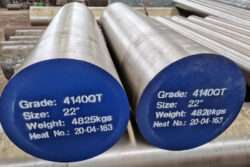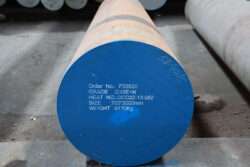Introduction

Alloy steel bars are pivotal components in modern manufacturing processes, offering a range of advantages over conventional steel. This blog explores the various benefits of utilizing alloy steel bars across different industries.
What is Alloy Steel Bar?
Alloy steel bars are steel bars that are alloyed with a variety of elements to enhance their mechanical properties. Common alloying elements include chromium, nickel, molybdenum, and vanadium. These additions impart specific characteristics such as increased strength, hardness, corrosion resistance, and wear resistance.
Key Properties of Alloy Steel
Alloy steel exhibit several key properties that make them desirable in manufacturing:
- High Strength: Alloying steel with elements such as chromium, nickel, and molybdenum increases its tensile and yield strength significantly, allowing alloy steel to withstand higher loads and stresses than conventional carbon steel counterparts.
- Hardness: Alloy steel exhibit greater hardness due to the presence of alloying elements like manganese and silicon, which form carbides during heat treatment. This hardness makes alloy steel suitable for applications requiring resistance to abrasion and deformation.
- Corrosion Resistance: The addition of chromium in alloy steel forms a protective oxide layer on the surface, enhancing their resistance to corrosion from moisture, chemicals, and other environmental factors. This property is crucial for applications in marine environments and industrial settings where exposure to corrosive substances is common.
- Wear Resistance: Molybdenum and vanadium are alloying elements that contribute to the formation of hard carbides within the steel matrix, significantly improving its resistance to wear and abrasion. This makes alloy steel ideal for components subjected to friction and wear, such as gears, shafts, and cutting tools.
Applications of Alloy Steel Bar
Alloy steel bars find applications in diverse industries:
- Automotive: Engine components, gears, and axles.
- Aerospace: Landing gears, turbine blades, and structural components.
- Construction: Structural supports and reinforcement bars.
- Energy: Drill rods, pipelines, and turbines.
Advantages of Using Alloy Steel Bar
Alloy steel bars offer several advantages over other materials:
- Enhanced Strength: Alloy steel bars offer a higher strength-to-weight ratio compared to traditional carbon steel, making them ideal for applications where weight reduction is critical without sacrificing structural integrity. This characteristic allows manufacturers to design lighter yet stronger components, contributing to overall efficiency and performance.
- Durability: Due to their enhanced hardness and resistance to wear, alloy steel exhibit exceptional durability, making them suitable for prolonged use under harsh conditions. They withstand repetitive stress, impact loading, and abrasive environments better than many other materials, minimizing the risk of premature failure and downtime.
- Versatility: Alloy steel bars are highly versatile in manufacturing processes due to their ability to undergo different machining techniques and heat treatments. This versatility allows for precise shaping and customization of components to meet specific design requirements, enhancing their functional capabilities across diverse applications and industries.
- Cost Efficiency: The longer service life of alloy steel translates into significant cost savings over time by reducing the frequency of replacements and maintenance. Their superior durability and resistance to wear and corrosion minimize downtime and operational disruptions, optimizing overall production efficiency and lowering total lifecycle costs.
Case Studies: Alloy Steel Bar in Action
Automotive Industry Case Study
Alloy steel bars in automotive applications enhance performance and safety:
| Component | Alloy Steel Application |
|---|---|
| Engine Components | Crankshafts, camshafts |
| Suspension Systems | Springs, stabilizer bars |
| Safety Components | Roll bars, chassis reinforcements |
Aerospace Industry Case Study
Alloy steel play a critical role in aerospace engineering:
| Component | Alloy Steel Application |
|---|---|
| Turbine Blades | High-temperature alloys |
| Structural Components | Wing spars, landing gears |
| Fasteners | High-strength bolts |
Environmental Impact and Sustainability

Alloy steel contribute to sustainability through:
- Longevity: Alloy steel are known for their durability and resistance to wear, which results in extended service life compared to other materials. This longevity reduces the frequency of replacements and the amount of raw materials consumed over time, contributing to resource conservation and sustainability efforts.
- Recyclability: Steel, including alloy steel, is one of the most recyclable materials in the world. At the end of its useful life, alloy steel can be easily recycled and reused without losing its inherent properties. This reduces the demand for virgin raw materials, lowers energy consumption in production, and minimizes waste sent to landfills, thus supporting a circular economy and reducing the environmental footprint of manufacturing processes.
Conclusion
Alloy steel bars are indispensable in modern manufacturing due to their superior mechanical properties and versatility across industries. Their application extends from automotive to aerospace sectors, offering enhanced strength, durability, and cost efficiency.
FAQ
Q:What are alloy steel bars made of?
A:Alloy steel bars are primarily made of iron with added alloying elements such as chromium, nickel, molybdenum, and vanadium.
Q:How are alloy steel bars different from carbon steel bars?
A:Alloy steel bars contain additional alloying elements that enhance specific properties like strength, hardness, and corrosion resistance, whereas carbon steel bars primarily consist of iron and carbon.
Q:What are the main advantages of using alloy steel bars?
A:The main advantages include higher strength, improved hardness, enhanced corrosion resistance, better wear resistance, and cost efficiency due to longer service life.
